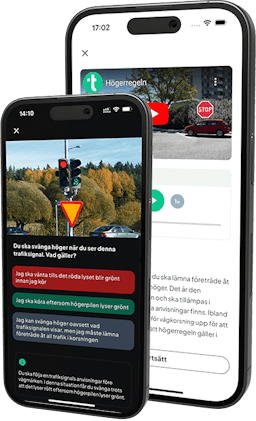There are many specific rules about when you are allowed and not allowed to overtake. To summarise and put things simply, you should generally overtake on the left and without any risk of danger.
Before overtaking another vehicle, you must be certain that you can do so without risk. If you find yourself in a dangerous situation when overtaking, you should brake and abandon the overtake.

It is not Permitted to Overtake in the Following Situations
- When you are being overtaken; i.e. when the vehicle behind has begun overtaking you.
- Right before or at an uncontrolled pedestrian crossing or bicycle crossing.
- When visibility is obstructed at the crest of a hill or on a bend. Exception: Overtaking is permitted if there are several lanes in each direction of traffic or if you do not need to cross the centre line.
- When oncoming traffic is approaching. Exception: Overtaking is permitted if you do not need to cross the centre line and put yourself in the same lane as oncoming traffic.
- If the vehicle in front is going to make a left turn, then you may not overtake on the left.
- When there is poor visibility due to weather conditions such as heavy rain, heavy snowfall or fog.
- Right before and at junctions where the priority to the-right rule applies. Exception: You can overtake two-wheel vehicles and vehicles which clearly indicate their intention to make a left turn, provided that you overtake them on the right.
- Right before and at level crossings without gates or lights. Exception: You can overtake two-wheel vehicles in this situation.
- In places where the No overtaking sign is displayed.

Which Side You Should Overtake on
In general, you should overtake on the left, although there are some exceptions:
- Cyclists and class II mopeds can overtake other vehicles on the right.
- At places where roadworks are being undertaken, you can pass roadwork machines on whichever side best suits the situation. If there is a roadwork machine on the left-hand side of the carriageway, then it is probably best to overtake the vehicle on the right.

- If the carriageway has at least two lanes in the same direction and the speed limit is 70 km/h or lower, then overtaking on the right is permitted.
- If the vehicle in front turns to the left, then you must overtake on the right.
- If a vehicle is driving in a lane that leads to another destination, then you can overtake on the right.
When You are Overtaken
In addition to rules on how to behave when overtaking, there are also rules on what to do when being overtaken yourself:
- You must keep to the right in order to make it easier for the other driver to overtake you. You can also use the hard shoulder in order to assist the overtake.
- You must not increase your speed and if there is a lot of traffic, you may even reduce your speed in order to make it easier for the other driver to overtake you.
- Try to keep a good distance from the vehicle in front so that the overtaking vehicle can easily return to the right lane.
- You must not obstruct the overtake in any way, even if the overtake is illegal or inappropriate.
Types of Overtake
Accelerative overtake is when you are behind another vehicle and you increase your speed in order to overtake.
Flying overtake is when you approach a vehicle at a considerably higher speed and overtake. You do not need to accelerate to overtake.
Flying overtakes are preferable as you do not need as long a distance in order to perform the overtake. It takes a longer time and the distance becomes longer if you need to accelerate. Flying overtakes also reduce fuel consumption since you maintain a steady speed as you perform the overtake.


